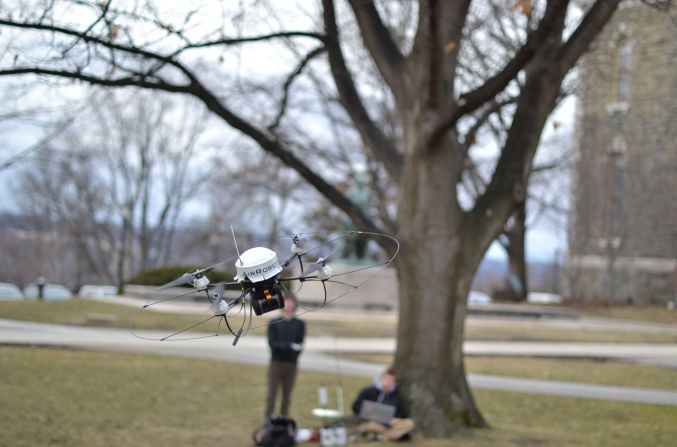A new autonomous flying robot has been developed by the Computer Science Department at Cornell University. The robot is able to avoid obstacles totally by itself, without any human guidance. It produces a 3D map of its environment and then locate the obstacles within the map. Autonomously locating the obstacles while flying has a main advantage over remote controlled operation, such as the ability to perform without needing to receive timely signals from the operator. A commercially available drone was used as the base equipment. The project also received funding from DARPA and Lockheed Martin. Autonomous flying drones can have many uses as they become more and more common, such as mapping various locations automatically, search and rescue missions, surveillance and many more. You can get more details at: http://mav.cs.cornell.edu/
Assistant Professor Ashutosh Saxena, Graduate Students Ian Lenz and Mevlana Gemici at Computer Science Department of Cornell University, developed the robot. Ashutosh Saxena answered our questions:
Robotic Magazine: There has been a lot of work that we have seen in the news about autonomous cars. What are the main differences and similarities between an autonomous vehicle operating on land vs air? Also answer in terms of visual processing.
Ashutosh Saxena: There are two main differences: 1. Sensing. On a car, one can mount larger sensors because the power and weight requirements are less stringent. Furthermore, car is big; therefore one can mount sensors having larger “baseline”. On the other hand, aerial robots have very strong fundamental power and weight limitations. 2. Computing. Similarly, aerial robots also have limited computing capacity, and algorithms need to work with limited power.
http://www.youtube.com/watch?feature=player_embedded&v=PpUnVRb3Hx0
Robotic Magazine: What kind of sensors are there on your robot? Are there gps or wifi employed?
Ashutosh Saxena: The main crux of the work is on visual obstacle avoidance. And this does not require GPS. However, GPS could be used on outdoor robots to autonomously reach a geographic location. WIFI or some other communication method is needed for communicating with the person who may want to see the video from the onboard camera (or giving high-level commands).
Robotic Magazine: What is the software being used?
Ashutosh Saxena: A spiking neural inspired version of Make3D algorithm.
Robotic Magazine: What are the planned uses for your robot and will it be available for sale to general public? If so when and what is your price range expectation?
Ashutosh Saxena: Search and rescue operations. These robots can into disaster areas where ground robots cannot. Recent robots such as Parrot Drone are inexpensive, e.g., $300.
http://www.youtube.com/watch?feature=player_embedded&v=pUj7Ryom03c
Robotic Magazine: Is there also a remote control operation possible?
Ashutosh Saxena: Yes.
Robotic Magazine: In one of the videos, the robot is provided with a 3d map of the environment first. But at the end the robot is also seen to operate in an unknown indoor environment without a map. Can you explain this a little further?
Ashutosh Saxena: The robot can operate in both modes, with or without map. The key goal is not to crash into obstacles.
Image and Video Credits: Cornell University, Saxena Lab.


